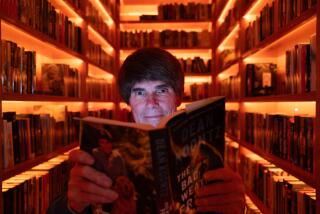Ingenious Mind Games Drive the Plot in Koontz Thriller
- Share via
In the first third of Dean Koontz’s latest thriller, on one eerily wintry Southern California day, everybody seems to be going crazy at once.
Dusty Rhodes, a painting contractor, arrives on the job to find that one of his employees, his gentle but drug-addled half-brother Skeet, is about to jump off a roof. The angel of death--who looks, Skeet says, a lot like Billy Crystal--has “instructed” him to commit suicide.
Dusty rescues Skeet and takes him to a clinic where he has undergone rehab before. Then another strange thing happens. Dusty finds a slip of paper on which Skeet has written “Dr. Yen Lo.” When Dusty says this name aloud, Skeet goes into a trance, obedient to any command, and remembers nothing when he wakes.
Meanwhile, Dusty’s wife, Martie, a video-game designer, takes her friend Susan Jagger, who suffers from acute agoraphobia--fear of open spaces--to visit the renowned therapist Dr. Mark Ahriman. It’s an exhausting struggle for Martie to persuade Susan to leave home and get into a car, though she always feels better in Ahriman’s office.
On this day, Susan confides to Martie something even weirder: Someone--her estranged husband?--has been sneaking into her locked apartment at night and having rough sex with her, leaving semen and bruises, without waking her up. How can this be? Has her phobia progressed to insanity? Martie reassures her to the contrary, though she has begun to feel equally alarming, though different, symptoms.
Martie is developing autophobia, a fear of herself, particularly of her capacity for violence. She hides it from Susan, but back home she becomes convinced that she will mutilate and murder Dusty, whom she loves. So she sets about destroying every potential weapon in the house. When Dusty gets back from tending Skeet, he finds his hysterical wife surrounded by trash bags full of wrecked kitchen utensils and power tools.
So far, in this first third of “False Memory,” Koontz has done what he does so well: create smart and likable characters, subject their virtues to extreme pressure, maintain suspense on two narrative lines at once and conjure creepiness out of a place whose palm trees and pastels and security gates have been designed precisely to keep the dark side of life at bay.
But then, 200 pages into a 600-page story, Koontz takes a risk. He explains things. What’s happening to Skeet and Martie and even to Dusty, who begins to notice curious lapses in his otherwise photographic memory, isn’t craziness after all--not the random onset of mental illness in all its mystery. It’s part of a plot.
There’s a villain at work, with a genius I.Q., high-level connections, great wealth--the typical thriller villain, in other words. He takes sadistic glee in programming people to carry out crimes to which he can’t be connected. He’s a “gamesman” who likes to leave his victims a few clues--”Dr. Yen Lo,” for example, one of the characters in Richard Condon’s novel of Korean War-era brainwashing, “The Manchurian Candidate.”
Dusty and Martie have to use those clues, his memory, the strength she inherited from her heroic firefighter father and the unwavering love of their golden retriever, Valet, to battle an evil that has literally invaded their minds. And they have to find out in time why the villain has selected them.
This is exciting but more predictable than the beginning of the novel. In Koontz’s universe, as we know by now, good people have no help but one another. The government is compromised. The police are cowed or corrupt. Experts are worse than useless. (In “False Memory,” the psychiatric profession, in particular, takes a lambasting.)
Evil has all the advantages, except believability; Koontz’s villains are as dead, in a literary sense, as his dogs are alive.
More to Read
The biggest entertainment stories
Get our big stories about Hollywood, film, television, music, arts, culture and more right in your inbox as soon as they publish.
You may occasionally receive promotional content from the Los Angeles Times.










